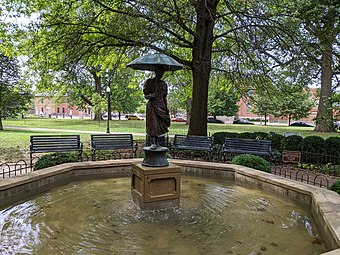Schiller Park (Columbus, Ohio)
| Schiller Park | |
|---|---|
| Friedrich von Schiller Park | |
 Pond and bridge at Schiller Park | |
 | |
| Type | Public |
| Location | 1069 Jaeger Street, German Village, Columbus, Ohio |
| Coordinates | 39°56′31″N 82°59′34″W / 39.94194°N 82.99278°W |
| Area | 23.45 acres (9.49 ha) |
| Established | 1867 |
| Administered by | Columbus Recreation and Parks Department |
| Public transit access | |
| Website | Schiller Park |
Schiller Park is a 23.45-acre (9.49 ha) municipal park located in German Village, a historic neighborhood in Columbus, Ohio.[1] The park is bounded by Reinhard Avenue to the north, Jaeger Street to the east, East Deshler Avenue to the south, and City Park Avenue to the west.[1]
Description and history[edit]

During the nineteenth century, the land was originally owned by Francis Stewart and was known as "Stewart's Grove."[2][3] It had been the area's center for festivals and neighborhood activities since the 1800s, including the Independence Day celebration of 1830 and Ohio State Fairs of 1864 and 1865.[1][2] By 1866, David W. Deshler, his son William G. Deshler, and Allen G. Thurman purchased the property with the aim of having it permanently serve the public.[2] Shortly afterwards, the City of Columbus purchased the park in April 1867 for $15,000 from the Deshlers and Thurman.[4][5][6] Upon purchase, the park was renamed "The City Park" and is ranked as the second oldest park in the city following Goodale Park.[2][4]
Between the middle and end of the nineteenth century, the area surrounding "City Park" became increasingly populated by German immigrants.[7] On July 4, 1891 during a Fourth of July celebration, a statue of Johann Christoph Friedrich von Schiller (1759–1805) was dedicated to the park by the German-born residents.[4][8] Friedrich von Schiller was a famous German poet, philosopher, historian, and playwright.[7] The statue in German Village is a second casting of the original statue in Munich, Germany.[9] The original statue was designed and executed by Max von Widnmann and unveiled in Munich on May 9, 1863, an anniversary of Friedrich von Schiller's death.[9] The Columbus City Council passed Ordinance No. 22,233 on April 3, 1905 to rename "The City Park" to "Schiller Park" as a namesake.[7][10]
The park, once a community meeting ground for the German settlement, is now the site of recreational facilities, gardens, and an amphitheater. Free live performances of Shakespearean plays are enacted during the summer months courtesy of Actors' Theatre of Columbus.[11] Along the main entrance of the park, facing City Park Avenue, visitors are greeted by the Huntington Gardens that are sponsored by Huntington National Bank and maintained by volunteers. The park is also home to Umbrella Girl, dedicated to the citizens of German Village in October 1996 to replace Hebe, the missing original sculpture.
Gallery[edit]
-
The park and its shelterhouse beside German Village and Downtown Columbus
-
Umbrella Girl statue and fountain
-
Winding pathway amid park space
See also[edit]
References[edit]
- ^ a b c "Schiller Park". Germanvillage.com. German Village Society. Retrieved 17 August 2014.
- ^ a b c d "Surveyor's Journal Entry Nineteen: Public Health Issues Intensify the Need For Open Land and Preservation". Franklin County Engineer’s Office. Retrieved 17 August 2014.
- ^ Phillips, David E. (July 1907). "Monumental Inscriptions From Green Lawn Cemetery, Columbus, Ohio". The "Old Northwest" Genealogical Quarterly. 10. Columbus, Ohio: "Old Northwest" Genealogical Society: 256. Retrieved 25 August 2014.
- ^ a b c "Schiller Park". The City of Columbus, Recreation and Parks. City of Columbus, Ohio. Retrieved 16 August 2014.
- ^ Lentz, Ed (June 15, 2009). "Deshlers Made Their Mark On Developing Columbus". ThisWeek Community News. Dispatch Media Group. Retrieved 17 August 2014.
- ^ "Thurman, Allen Granberry, (1813 - 1895)". Biographical Directory of the United States Congress. United States Congress. Retrieved 17 August 2014.
- ^ a b c High, Jeffrey L.; Martin, Nicholas; Oellers, Norbert (2011). Who is This Schiller Now?: Essays on His Reception and Significance. Camden House. pp. 11–12. ISBN 9781571134882.
- ^ Betti, Tom; Sauer, Doreen Uhas (2012). Historic Columbus Taverns: The Capital City's Most Storied Saloons. The History Press. p. 56. ISBN 9781609496708.
- ^ a b Berlepsch, H. A. (1871). Munich: Its Art Treasures and Curiosities. Supplement to every Travelling Guide by H. A. Berlepsch. With a Plan of the City, and a Map of Its Environs. Bruckmann. pp. 47–48.
- ^ "An Ordinance No. 22,233 - The City Park, Authorizing Change of Name to Schiller Park". Columbus City Bulletin. City of Columbus: 613. April 3, 1905.
- ^ Tebben, Gerald (July 23, 2012). "Columbus Mileposts - July 23, 1982: At Schiller Park, Actors' Theatre Sets Stage For Midsummer Tradition". The Columbus Dispatch. The Dispatch Printing Company. Retrieved 17 August 2014.
External links[edit]
- Schiller Park by the Columbus Recreation and Parks Department
- Schiller Park by the German Village Society





